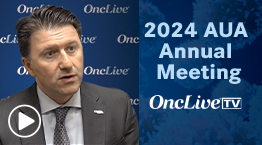Acalabrutinib Monotherapy Maintains Favorable Efficacy Over SOC Approaches in Relapsed/Refractory CLL
Single-agent acalabrutinib continued to showcase favorable efficacy, with a notable benefit in progression-free survival benefit over standard-of-care regimens and a consistent toxicity profile, in patients with relapsed/refractory chronic lymphocytic leukemia.
Paolo Ghia, MD, PhD

Single-agent acalabrutinib (Calquence) continued to showcase favorable efficacy, with a notable benefit in progression-free survival (PFS) benefit over standard-of-care (SOC) regimens and a consistent toxicity profile, in patients with relapsed/refractory chronic lymphocytic leukemia (CLL), according to follow-up data from the final analysis of the phase 3 ASCEND trial (NCT02970318) presented during the 2022 EHA Congress.1
At approximately 4 years of follow-up, acalabrutinib prolonged investigator-assessed PFS vs idelalisib (Zydelig) plus rituximab (Rituxan; IdR) or bendamustine plus rituximab (BR) in the overall patient population (n = 310). The median PFS was not yet reached with acalabrutinib vs 16.8 months with SOC regimens (HR, 0.28; 95% CI, 0.20-0.38; P < .0001). The estimated 42-month PFS rates in the investigative and control arms were 62% (95% CI, 53.2%-69.1%) and 19% (95% CI, 12.9%-26.1%), respectively.
Moreover, the median overall survival (OS) was not yet reached in either the acalabrutinib arm or the IdR/BR arm (HR, 0.69; 95% CI, 0.46-1.04; P = .0783). The estimated 42-month OS rates in these arms were 78% (95% CI, 71%-84%) and 65% (95% CI, 56%-72%), respectively. The objective response rates (ORR) between the arms were reported to be comparable.
“These results confirm that long-term acalabrutinib treatment as a chemotherapy-free regimen maintains efficacy and continues to be safe for patients with CLL who either relapsed after or stopped responding to previous treatments,” study author Paolo Ghia, MD, PhD, of Universitá Vita-Salute San Raffaele and IRCCS Ospedale San Raffaele, and colleagues, wrote in a poster on the data.
In November 2019, the FDA approved the next-generation, highly selective, covalent BTK inhibitor acalabrutinib for the treatment of patients with CLL or SLL based on data from 2 randomized clinical trials that compared acalabrutinib with other standard therapeutic options.2 In the first trial, acalabrutinib resulted in a longer PFS vs other standard treatments in 535 patients with previously untreated CLL. Data from the second study revealed that the agent also prolonged PFS over standard therapies in 310 patients with previously treated disease.
The multicenter, open-label ASCEND trial enrolled patients who were at least 18 years of age with a diagnosis of CLL that was defined by the International Workshop on Chronic Lymphocytic Leukemia criteria, who received 1 or more prior therapies for their disease, and an ECOG performance status of 0 to 2.
Those with known central nervous system lymphoma or leukemia, significant cardiovascular disease, or previous exposure to a BCL-2 or BCR inhibitor, were excluded.
A total of 310 patients with relapsed or refractory CLL were randomized 1:1 to receive oral acalabrutinib at a twice-daily dose of 100 mg (n = 155) or investigator’s choice of IdR or BR (n = 155).
Those within the control arm who received IdR were given oral idelalisib at a twice-daily dose of 150 mg plus intravenous (IV) rituximab at 375 mg/m2 on day 1 of the first treatment cycle and then at subsequent doses of 500 mg/m2 every 2 weeks for 4 infusions followed by every 4 weeks for 3 infusions. Those who received the BR regimen were given IV bendamustine at 70 mg/m2 on days 1 and 2 of cycles 1 through 6 in combination with IV rituximab given at 375 mg/m2 on day 1 of the first cycle and then subsequent doses at 500 mg/m2 on day 1 of cycles 2 through 6.
Notably, patients on the control arm were permitted to crossover to the investigative arm upon confirmation of disease progression.
Stratification factors include presence of del(17p), ECOG performance status (0-1 vs 2), and number of prior therapies received (1 to 3 vs more than 4).
The primary end point of the trial was PFS, and key secondary end points included ORR, OS, and safety.
Data from the primary analysis of the trial showed that at a median follow-up of 16.1 months (range, 0.03-22.4), single-agent acalabrutinib provided a superior PFS benefit over IdR or BR. In the investigative arm, the median PFS had not yet been reached vs 16.5 months (95% CI, 14.0-17.1) with investigator’s choice of treatment (HR, 0.31; 95% CI, 0.20-0.49; P < .0001).3 Findings from the follow-up analysis showed that with approximately 3 years of follow-up, the BTK inhibitor maintained its efficacy and continued to demonstrate an acceptable safety profile.4
The final analysis of the trial was performed to understand the long-term safety and efficacy of acalabrutinib monotherapy vs SOC treatment in this patient population.
Baseline and disease characteristics were found to be similar across the treatment arms. The median age in all 310 patients was 67 years (range, 32-90), 67.1% were male, 48.7% had bulky disease, and 41.6% had Rai stage III to IV disease.
Moreover, the median number of prior therapies received was 2, with a range of 1 to 10 treatments. Specifically, 48.1% of patients received 1 prior line of treatment, 27.7% received 2 prior lines, 13.2% received 3 lines, and 11.0% received 4 or more lines. Regarding cytogenetic status, 73.5% of patients had unmutated IGHV, 15.5% had del(17p), and 26.8% had del(11q).
Additional data from the final analysis showed that acalabrutinib significantly prolonged PFS in those with del(17p) and unmutated IGHV, as well as across prespecified subgroups.
Specifically, in those with del(17p), the median PFS with acalabrutinib was not yet reached vs 13.8 months with IdR/BR (HR, 0.13; 95% CI, 0.06-0.29; P < .0001). In those without del(17p), the median PFS had not yet been reached with acalabrutinib vs 20.3 months with IdR/BR (HR, 0.32; 95% CI, 0.23-0.45; P < .0001). In those with unmutated IGHV, the median PFS in the investigative and control arms was not reached and 16.2 months, respectively (HR, 0.29; 95% CI, 0.20-0.41; P < .0001). In those with mutated IGHV, the median PFS was not reached with acalabrutinib vs 36.5 months with Idr/BR (HR, 0.34; 95% CI, 0.13-0.93; P = .0270).
The median treatment exposure was longer with acalabrutinib than with IDR or BR, at 44.2 months vs 11.5 months and 5.6 months, respectively.
The most common adverse effects (AEs) of any grade among patients treated with acalabrutinib included neutropenia, headache, diarrhea, and upper respiratory tract infection. Grade 3 or higher toxicities that were most frequently reported with acalabrutinib were neutropenia, anemia, and pneumonia.
Serious AEs that occurred in 5% or more of patients in any group included pneumonia (9%, acalabrutinib; 10%, IdR; 3%, BR), diarrhea (1%, acalabrutinib; 16%, IdR; 0%, BR), and pyrexia (3%, acalabrutinib; 7%, IdR; and 3%, BR.
Bleeding events and atrial fibrillation were more commonly reported in those who received acalabrutinib although incidences of major hemorrhage and hypertension were low and comparable across the treatment groups.
“Fewer patients treated with acalabrutinib than IdR discontinued treatment due to AEs,” the study authors concluded.
References
- Ghia P, Pluta A, Wach M, et al. Acalabrutinib vs rituximab plus idelalisib or bendamustine in relapsed/refractory chrinc lymphocytic leukemia: ASCEND results at ~4 years of follow-up. Presented at: 2022 EHA Congress; June 9-12, 2022; Vienna, Austria. Abstract P668. Accessed June 10, 2022.
- FDA takes second action under international collaboration, approves new treatment option for patients with chronic lymphocytic leukemia. News release. FDA. November 21, 2019. Accessed June 10, 2022. https://bit.ly/3MHdImS
- Ghia P, Pluta A, Wach M, et al. ASCEND: phase III, randomized trial of acalabrutinib versus idelalisib plus rituximab or bendamustine plus rituximab in relapsed or refractory chronic lymphocytic leukemia. J Clin Oncol. 2020;38(25):2849-2861. doi:10.1200/JCO.19.03355
- Jurczak W, Pluta A, Wach M, et al. Three-year follow-up of the Ascend trial: acalabrutinib vs rituximab plus idelalisib or bendamustine in relapsed/refractory chronic lymphocytic leukemia. Blood. 2021;138(suppl 1):393. doi:10.1182/blood-2021-146570



